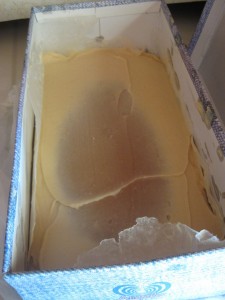 On my last trip to the local library, I checked out Catherine Bardey’s [amazon asin=1579120598&text=Making Soaps and Scents], thinking I could learn a few more recipes and tips for my new soap-making endeavor. The book is exactly what it advertises in the title—instructions for how to make soap and scents.
On my last trip to the local library, I checked out Catherine Bardey’s [amazon asin=1579120598&text=Making Soaps and Scents], thinking I could learn a few more recipes and tips for my new soap-making endeavor. The book is exactly what it advertises in the title—instructions for how to make soap and scents.
The Good: There are quite a few good ideas in this book, a helpful troubleshooting section (so if something goes wrong, you can determine what the problem is and whether you can fix it/how to fix it), a standard SAP index for figuring out how much lye and water to use depending on the oil type, and nice historical information (how well documented? not sure…). There are quite a few interesting variations, and Bardey includes recipes for shampoo bars and hair rinses—interesting idea. I love my shampoo, so I’ll have to think about it, but it could definitely be a fun gift. In addition, the scent section is interesting. I’m interested in trying solid perfumes, and she had no recipes for that, but who knew cologne could be made with vodka? Probably everyone but me, but I learned something, and that’s good. There is a healthy list of resources, but given the book is now thirteen years old, I’ll bet many of them are no longer available.
The bad: Almost all the soap recipes are based on her vegetable basic soap recipe or her animal basic soap recipe. She uses vegetable shortening in her soap, and I’ve heard of other folks using that, but what if I don’t want Crisco® in my soap? I would basically need to ditch the recipe and start with my own basic oil mixture and her additives, by which time, I may have created some sort of Frankenstein monster soap that won’t play nice with the additives (for all I know). I would have liked to have seen more variety in the recipes, and more discussion of the variety of oils. She doesn’t help out with that much aside from the SAP value chart in the back, and even then, there is no discussion of why you might use one oil over another and how that might impact your recipe. Which is huge! Another quibble I have with the book is that it is an odd size: 9.5 x 4.7 x 0.8 inches. In shape, it has roughly the same dimensions, length and width, as a standard envelope. That limited the size of the pictures. Soap-making books should have a ton of pictures, and this one has some good pictures, but not enough of them. I want to see more. A final quibble: no mention of using a stick blender to help you reach trace faster. In fact, Bardey discourages using hand mixers. Almost every website and book I’ve looked at recommends using stick blenders. I can’t believe that so many excellent soap-makers are wrong. Plus, my own experience is that it worked great. I can’t see why she discourages the use of anything but a wooden or stainless steel spoon. Seems odd to me, and I’d hate for a beginner to be put off soap-making by following that recommendation and finding the process more difficult and perhaps giving up. I know I wouldn’t want to be stirring the soap forever before something happened. Screw that.
The Verdict: This book has some good information, but it’s not for beginners, and is really not diverse enough to be worth hunting down to add to your collection. I found Basic Soap Making by Elizabeth Letcavage and Patsy Buck much more helpful for beginners as well as as a great addition to a more experienced soap-maker’s library. It has more variety in terms of recipes and more helpful information and pictures. I still learned some interesting information from Making Soaps & Scents, and for that reason, I think it’s worth checking out of the library (if your library has it), but it’s not the kind of book I’d consult more than once (well, maybe the troubleshooting section, but that’s it).
Rating:








